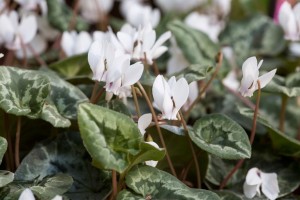 Garden cyclamen, sometimes known as hardy cyclamen, are subtle plants and easy to forget when they are not in leaf or flower. I forgot mine completely until I noticed that they hadn’t appeared this year. I don’t know what happened, but I blame the squirrels who have rampaged through the garden, digging with impunity and abandon.
Garden cyclamen, sometimes known as hardy cyclamen, are subtle plants and easy to forget when they are not in leaf or flower. I forgot mine completely until I noticed that they hadn’t appeared this year. I don’t know what happened, but I blame the squirrels who have rampaged through the garden, digging with impunity and abandon.
Now that the fall bulb shipment has arrived, I can rectify the situation.
Cyclamen flowers are as beautiful and delicate as the butterflies they resemble, floating close to the ground in the garden and often popping into view when you are looking at or for something else. For those who don’t know them, the little garden plants are the smaller relations of the florists’ cyclamen—Cyclamen persicum—that are sold as potted plants for winter display. The key recognition elements are the same, with the most prominent being single, five-petaled flowers that bloom at the tops of the stalks. Those petals are either reflexed or held upright, depending on the species or variety, and the overall flower configuration is orchid or butterfly-like. The colors run to shades of white, pink or red.
In both florists’ and garden varieties, the foliage is as beautiful as the flowers. The ivy-leafed cyclamen—Cyclamen hederifolium—have, as the name suggests, leaves that are shaped like those of English ivy. They are marked and marbled with gray-green and silver, making a healthy clump look like a miraculously woven damask cloth. The leaves appear after the flowers, prolonging the season of interest.
All cyclamen are members of the primrose family. Garden varieties have long inspired plaudits from all manner of garden pundits. In her book, The Little Bulbs, the great twentieth century American garden writer Elizabeth Lawrence rhapsodized over “the frail elegance of these tiny flowers.”Her older contemporary, English garden writer E.A. Bowles, wrote in My Garden in Autumn and Winter:
“I have an insatiable desire for Cyclamens, and could never have too many, for I know of no other plant that will turn patches of dust under thick trees into stretches of beauty so permanently and thoroughly.”
Cyclamen are the ultimate good mixers, with a diminutive size that allows them to fit into almost all garden situations. English garden writer and poet Vita Sackville-West planted them in her thyme lawn, which sounds lovely, but is a little surprising, as thyme is a sun lover and cyclamen is generally more partial to dry shade. Perhaps, though, Vita’s cyclamen were on the shady edges of the Sissinghurst thyme lawn. In non-Sissinghurst gardens, the little bulbs might easily fit into pockets under trees à la E.A Bowles, or at the feet of shrubs in semi-shaded areas. They are also perfect for container culture, combined with other plants for four-season interest. In short, anyone who has dirt can have cyclamens.
My new ivy-leafed cyclamen, which will go into my garden in a matter of days, have been cultivated and documented for centuries. Maggie Campbell-Culver, in her wonderful book, The Origin of Plants, notes that Cyclamen hederifolium was introduced in England in 1597, during the reign of Queen Elizabeth I and the theatrical era of William Shakespeare. It became known as “sow bread,” an extremely ugly name for such a beautiful plant.
According to students of plant lore, the cyclamen corms or swollen underground roots resembled small loaves and were much sought after by hungry Elizabethan pigs. Notwithstanding the efforts of those swine, cyclamen prospered in English gardens and eventually made their way to America. Early Americans also had pigs, of course, but apparently cyclamen survived and prospered here anyway.
People bitten by the cyclamen “bug” may also plant Cyclamen coum, another late fall bloomer with a somewhat greater color range than the ivy-leafed species. Coum also thrives in dry shade and bears the distinctive mottled foliage. West Virginia plantsman Barry Glick, of Sunshine Farm and Gardens, prefers it to ivy-leafed cyclamen for its expanded color and hardiness range. Since the world is always in need of good plants, my advice is to grow both types.
The great southern gardener, Nancy Goodwin, made cyclamen a specialty decades ago and started a nursery to get various seed-grown species and varieties out to the public. Sadly, her nursery, Montrose, is gone, but she still grows cyclamen and an array of other interesting plants. Many of her treasures are now offered by North Carolina’s Plant Delights Nursery, run by a wonderful, highly idiosyncratic plantsman named Tony Avent.
Gardeners frequently grouse about dry shade. Cyclamens flourish under those conditions and absolutely abhor soggy soil, which fosters root rot. Combine them with other shade lovers like hellebores and various types of lamium. If you have room, interplant the cyclamen with small varieties of daffodils and grape hyacinths, which bloom just as cyclamen is going into its dormant phase.
Most garden centers and nurseries carry few, if any, cyclamen. However, they are readily available online. Order cyclamen coum and other types from Sunshine Farm and Gardens, 696 Glicks Rd, Renick, WV 24966, (304) 497-2208, www.sunfarm.com. Order an array of cyclamen from Plant Delights Nursery, Plant Delights Nursery, Inc., 9241 Sauls Road, Raleigh, NC 27603, (919)772-.4794; www.plantdelights.com.
